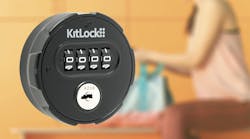A growing number of organizations won’t allocate new expenditures for access control unless these outlays leverage the existing infrastructure and applications. Other small- to medium-sized businesses (SMBs) simply don’t have the resources for strong logical access unless they can add it to their current system. Consolidating physical and logical access control onto a single credential creates opportunities for dealers and systems integrators to deliver important value to a new market segment.
Now, a new generation of smart card technology is enabling organizations to consolidate physical and logical access control onto a single, unified identity platform. Integrated, multi-application access control solutions are moving onto mobile devices including phones enabled with wireless Near Field Communications (NFC) technology.
Access gets mobilized
The latest combined identity solutions cut deployment and management costs while generating new market opportunities for dealers, installers and integrators. They improve security by enabling a single credential to be used for logical access including strong desktop authentication while simultaneously driving more robust identity authentication at the door. And they can help organizations enforce more consistent policies, while facilitating the use of consolidated audit logs throughout the enterprise.
Converged access control applications don’t need to be restricted to a physical smart card anymore. Identity information and encrypted communications, as well as data processing between reader and server or panel, can all be virtualized just like any other IT procedure. Once virtualized, they can operate on new platforms such as smartphones and other mobile devices that use wireless NFC technology to communicate with an access control reader. All that is required is a mechanism for securely managing the identity and authentication information on the device throughout its life cycle.
This management mechanism is available in the form of a standards-based- and technology-independent data structure, such as HID Global’s Secure Identity Object (SIO). SIO-enabled cards and readers perform similar functions to traditional cards and readers within HID Global’s Trusted Identity Platform (TIP) framework, using its patented technology for delivering access control solutions with the help of NFC technology. TIP ensures that all endpoints such as credentials, printers, readers and NFC phones can be validated and the transactions between them are secure. Combined with the smartphone subscriber identity module (SIM) technology, this network creates a trusted access control environment using SIO credentials and NFC wireless communication.
NFC mobile access devices verify a person’s identity and other relevant access rules, which ensure that future physical access control readers (and locks) are built without any significant intelligence or connectivity capabilities. NFC phones can then use cryptographically secure communications to send a trusted message to the door, telling it to open. Next, the reader must interpret the encrypted command. The readers (or locks) become unconnected, encrypted door switches that are less costly to build.
Integrated physical and logical access control developments on traditional and mobile platforms will continue to create new market opportunities, such as interior door, filing cabinet and storage unit applications. And access control deployments will only continue to move to mobile devices, creating convenient universal platforms for many different types of embedded keys and credentials.



